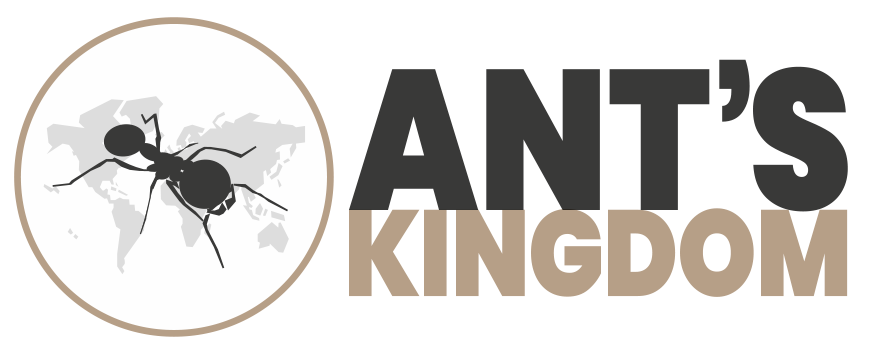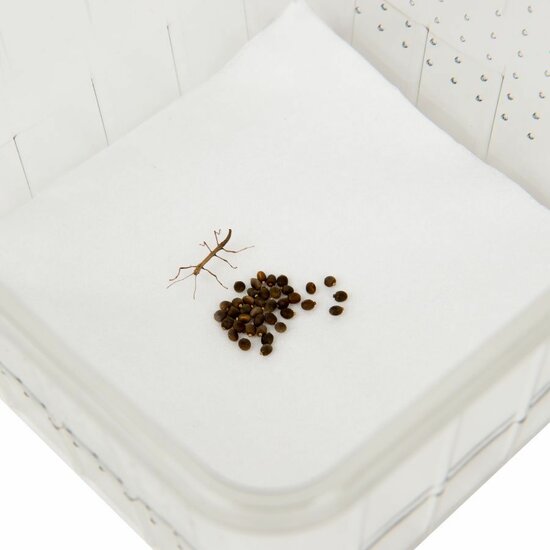
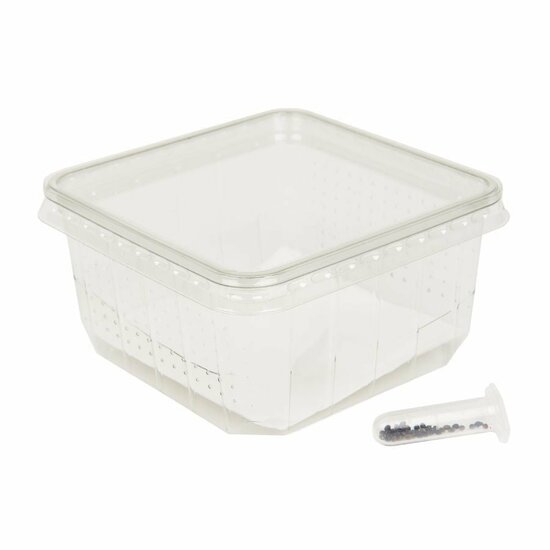
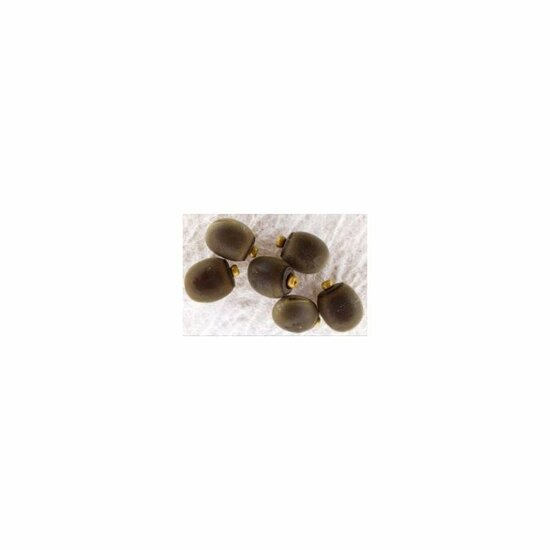
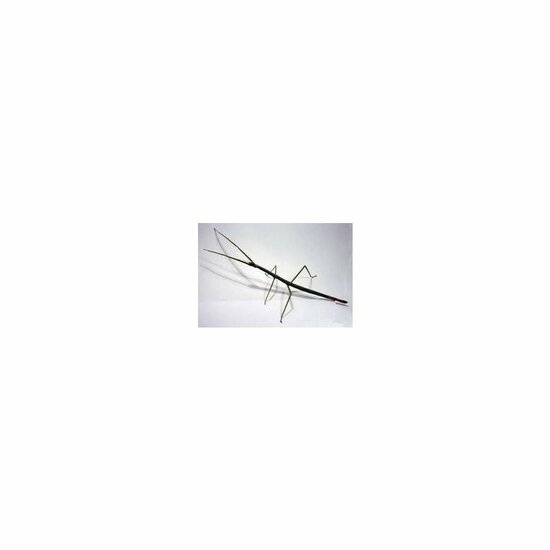




- Ants as pets since 2009 It starts here!
- We ship every working day until 4:30 PM
- Flat shipping costs from €6.99
- Specialists in ants, free advice
Do you have questions about this product?
Or do you need help? Please feel free to contact us, we are happy to help!
Product description
Breeding kit with PSG1 eggs of the Indian Walking Stick
Set of eggs psg1
Order your breeding kit, a breeding tray and approximately 20 eggs of the Indian stick insect here. The eggs can be kept in the breeding container on damp paper (remoistening once a week is sufficient).
The eggs are on average a few weeks old, we send eggs of different ages together, so that there is always something to see under normal circumstances. Some are expected to be released within a few weeks to a few months, the rest within six months at the latest. Since the care and conditions are important for the hatching of the eggs, we cannot give any guarantees on the hatching of the eggs.
General info
Eggs for sale from the Indian Walking Branch. The Indian stick insect is also called laboratory stick insect and is the most commonly kept species of stick insect in the world. The species has also been given a PSG number, PSG 1. The official Latin name is Carausius morosus.
Most people also start with this species when they first start keeping stick insects. They are therefore very easy to keep and eat readily available food, namely ivy.
Movement and behavior
An Indian stick insect is a quiet animal. Because most stick insects are nocturnal, they will not show much movement during the day. However, in the evening you can see them moving and eating. They cannot bite, scratch or excrete poison and are easy to handle. They also cannot jump or fly.
Nutrition supply
This species eats many types of leaves. They are known for eating ivy. They can live on all kinds of ivy and they don't need other leaves to be healthy. You can feed them many other leaves, such as blackberry, raspberry, oak, rose, hazel and privet leaves. Bramble leaves and ivy can always be found in winter.
Plants from stores have been sprayed with insecticides! This will kill your stick insects immediately if they are eaten.
Environmental requirements
The temperature may vary between 18 °C and 30 °C. Room temperature is therefore fine for these animals.
The stick insect does not make high demands on humidity, sprinkling the enclosure twice a week as a basis is sufficient, watch out for mold development. They are also allowed to have some drinking water.
As with all stick insect species, the species requires an enclosure at least 3x the length of the animal in height, and at least 2x the length of the animal in width. For an adult female this means a size of at least 24 cm high and 16 cm wide.
Reproduction
This species is parthenogenetic in culture. This means that in captivity there are only females, and the eggs they lay still hatch without a male having been present. Once again, only females hatch from those eggs.
When the females are mature, they will start laying eggs. The eggs are round and brown and have a small cap from which the nymph will hatch later. They just throw them on the ground. The eggs hatch after a few months to six months.
Home-grown
Our eggs all come from our own farm and are well cared for before shipping.
Breeding kit with PSG1 eggs of the Indian Walking Stick
Set of eggs psg1
Order your breeding kit, a breeding tray and approximately 20 eggs of the Indian stick insect here. The eggs can be kept in the breeding container on damp paper (remoistening once a week is sufficient).
The eggs are on average a few weeks old, we send eggs of different ages together, so that there is always something to see under normal circumstances. Some are expected to be released within a few weeks to a few months, the rest within six months at the latest. Since the care and conditions are important for the hatching of the eggs, we cannot give any guarantees on the hatching of the eggs.
General info
Eggs for sale from the Indian Walking Branch. The Indian stick insect is also called laboratory stick insect and is the most commonly kept species of stick insect in the world. The species has also been given a PSG number, PSG 1. The official Latin name is Carausius morosus.
Most people also start with this species when they first start keeping stick insects. They are therefore very easy to keep and eat readily available food, namely ivy.
Movement and behavior
An Indian stick insect is a quiet animal. Because most stick insects are nocturnal, they will not show much movement during the day. However, in the evening you can see them moving and eating. They cannot bite, scratch or excrete poison and are easy to handle. They also cannot jump or fly.
Nutrition supply
This species eats many types of leaves. They are known for eating ivy. They can live on all kinds of ivy and they don't need other leaves to be healthy. You can feed them many other leaves, such as blackberry, raspberry, oak, rose, hazel and privet leaves. Bramble leaves and ivy can always be found in winter.
Plants from stores have been sprayed with insecticides! This will kill your stick insects immediately if they are eaten.
Environmental requirements
The temperature may vary between 18 °C and 30 °C. Room temperature is therefore fine for these animals.
The stick insect does not make high demands on humidity, sprinkling the enclosure twice a week as a basis is sufficient, watch out for mold development. They are also allowed to have some drinking water.
As with all stick insect species, the species requires an enclosure at least 3x the length of the animal in height, and at least 2x the length of the animal in width. For an adult female this means a size of at least 24 cm high and 16 cm wide.
Reproduction
This species is parthenogenetic in culture. This means that in captivity there are only females, and the eggs they lay still hatch without a male having been present. Once again, only females hatch from those eggs.
When the females are mature, they will start laying eggs. The eggs are round and brown and have a small cap from which the nymph will hatch later. They just throw them on the ground. The eggs hatch after a few months to six months.
Home-grown
Our eggs all come from our own farm and are well cared for before shipping.
Reviews
No reviews yet
More information...
If you have any questions, please don't hesitate to contact us, we like it! You can reach us via email and WhatsApp. You are welcome in the showroom by appointment for advice and purchase!
Customer service Make an appointment
